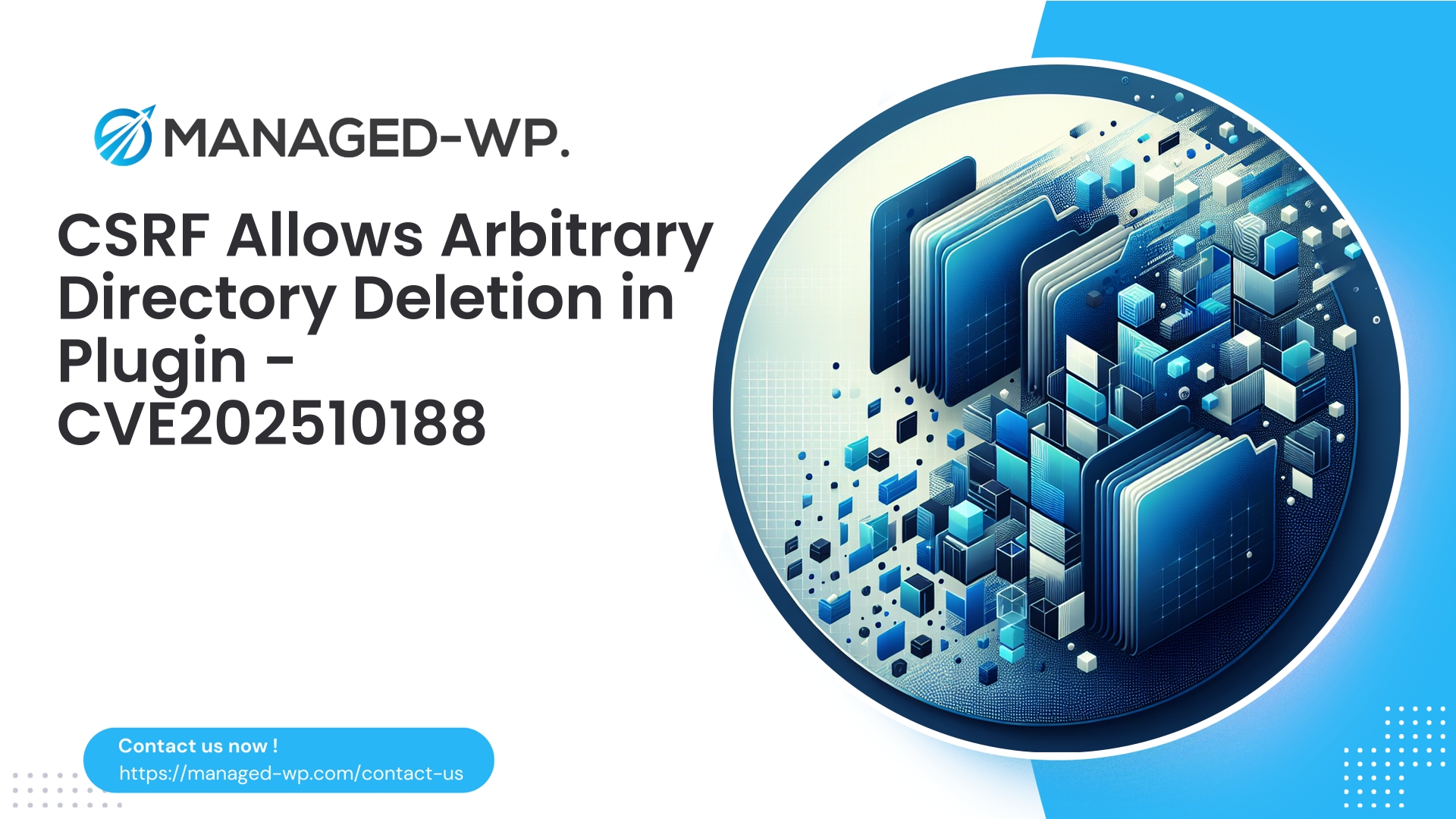| 插件名称 | 高效风格 |
|---|---|
| 漏洞类型 | 已认证存储型 XSS |
| CVE编号 | CVE-2025-8394 |
| 紧急 | 低的 |
| CVE 发布日期 | 2025-09-16 |
| 源网址 | CVE-2025-8394 |
以高效的方式利用已认证贡献者存储型 XSS 漏洞(≤ 1.1.23):WordPress 网站所有者和开发者的关键指南
在 Managed-WP,我们持续监控 WordPress 插件漏洞,以帮助网站所有者和开发者快速降低风险。最近披露的 Productive Style 插件中存在一个存储型跨站脚本 (XSS) 漏洞(编号为 CVE-2025-8394),该漏洞允许具有“贡献者”或更高角色的已认证用户通过该漏洞注入持久性恶意脚本。 显示生产面包屑 短代码。此漏洞已在 1.1.25 版本中修复。使用此插件的 WordPress 网站必须立即解决此问题,尤其是那些允许跨多作者博客和编辑平台进行贡献者级别访问的网站。
本公告概述了漏洞的性质、潜在的利用方法、检测技术、修复步骤以及开发最佳实践。此外,我们还将重点介绍 Managed-WP 提供的托管防火墙服务如何在更新期间保护您的网站。
执行摘要
- 漏洞: 通过 Productive Style 插件中的存储型 XSS
显示生产面包屑短代码。 - 受影响版本: ≤ 1.1.23。
- 已修复: 版本 1.1.25。
- 所需权限: 贡献者角色或更高角色(已认证用户)。
- CVE: CVE-2025-8394;CVSS 评分 6.5(中低)。
- 影响: 持久型 XSS 可以在访问者的浏览器中执行任意脚本,可能导致会话劫持、内容篡改、SEO 投毒或恶意重定向。
- 立即采取的行动: 请立即将插件更新至 1.1.25 或更高版本。如果无法立即更新,请采取缓解措施,例如禁用短代码、限制贡献者上传、清理存储的输入或通过托管 WAF 应用虚拟补丁。
了解漏洞
Productive Style 插件具有以下特点: 显示生产面包屑 此短代码用于渲染面包屑导航元素。该短代码无法正确处理拥有“贡献者”或更高权限的用户提交的输入,未能正确地清理或转义输出。此漏洞使得恶意脚本能够被注入到数据库中,并在每次向最终用户渲染面包屑时执行。
存储型 XSS 尤其危险,因为它允许攻击者维持持久的访问向量,从而影响管理员、编辑和访问者。
利用场景
- 攻击者控制或入侵贡献者帐户后,会通过表单、帖子元数据、分类字段或与面包屑输出关联的个人资料输入注入精心构造的脚本有效载荷。
- 当其他用户(例如,编辑、管理员或访客)加载包含易受攻击的短代码的页面时,存储的脚本会在该用户的浏览器中以网站的形式执行。
- 这可能导致会话劫持、未经授权的操作、内容篡改,或偷偷重定向到攻击者控制的网站。
由于贡献者通常可以创建内容但不能发布内容,因此当这些输入内容进入面包屑逻辑时,某些工作流程(例如,帖子标题、摘要或元字段)仍然存在风险。
影响和风险分析
- 保密性: 中等风险。如果未启用 HttpOnly 标志,攻击者控制的脚本可以窃取令牌或会话 cookie。
- 正直: 中等风险。脚本可能会修改显示的内容或在受害者的已认证会话中执行操作。
- 可用性: 低风险。虽然 XSS 很少导致服务中断,但它可能会传播破坏性脚本。
- 声誉与搜索引擎优化: 高风险。恶意注入可能导致搜索引擎因发布垃圾邮件或钓鱼内容而受到处罚。
CVSS 评分为 6.5,表明存在中等程度的威胁,应该认真对待,特别是对于有多个贡献者或用户交互频繁的网站。
如何评估您的网站是否受到影响
- 请验证 Productive Style 插件的安装和激活状态:
- 导航至 WordPress 管理后台 → 插件,找到 Productive Style 插件。
- 检查插件版本;如果版本≤1.1.23,则您的网站存在漏洞。
- 如果您无法立即更新:
- 扫描您的内容存储,查找可疑的脚本标签或内联 JavaScript。
推荐的搜索策略包括:
- 搜索帖子内容、元数据、小部件和选项中的子字符串,例如
<script,错误=, 或者javascript:. - 使用 WP-CLI 查询数据库以查找可疑输入(示例如下):
# 检查文章和页面中的脚本标签 wp 数据库查询“SELECT ID, post_title, post_type FROM wp_posts WHERE post_content LIKE '%'
- 使用网站爬虫或安全扫描器来识别内容中意外的内联脚本。
重要的: 避免在生产环境中执行或测试可疑的有效载荷。请使用预发布或测试环境进行验证。
立即采取的补救措施
- 请将 Productive Style 插件更新至 1.1.25 或更高版本:
- 使用 WordPress 控制面板 → 更新或插件 → 更新 Productive Style。
- 如果暂时无法更新:
- 请完全停用该插件,直到安装安全版本为止。
- 移除或禁用
显示生产面包屑在主题或内容中输出短代码。 - 限制贡献者的上传和编辑权限,以减少新的恶意输入。
- 扫描并清理存储的内容,删除可疑脚本;如有必要,从干净的备份中恢复。
- 实施额外的保护措施,例如托管 WAF 规则或虚拟补丁,以过滤和阻止针对此短代码的 XSS 有效负载。
- 如果怀疑密码泄露,请审查并重置具有“贡献者”或更高角色的用户的密码。
Managed-WP Web 应用程序防火墙 (WAF) 如何保护您
Managed-WP 的 WAF 解决方案部署虚拟补丁和服务器端过滤,在恶意载荷到达易受攻击的插件代码之前将其拦截。相关保护措施包括:
- 阻止包含两者的 POST 或 PUT 请求
显示生产面包屑以及脚本标签(例如,). - 过滤包含常见 XSS 模式的输入,例如
错误=或者javascript:尤其是在显示面包屑导航的页面上。 - 监控并限制已认证用户提交可疑 HTML 内容的速率。
如果无法立即更新,这些措施可以显著降低被利用的风险,同时保持网站的可用性和性能。
插件开发者和维护者的最佳实践
为了确保您的插件安全并防止此类漏洞,请遵守以下开发准则:
- 始终对输入进行严格清理,并对输出进行可靠的转义;将所有用户提供的数据视为不可信数据。
- 请勿使用:
- 请改用:
- 如果允许使用有限的 HTML,则必须严格限制标签的使用:
- 通过清理属性和转义输出来保护短代码处理程序:
- 对所有影响存储内容的 AJAX 或表单提交实施能力检查和随机数。
- 审核面包屑导航渲染中使用的所有数据源,并确保进行一致的清理或转义。
- 记录可疑的脚本注入尝试,以便及早发现潜在的滥用或账户被盗用行为。
// 易受攻击示例(请勿复现) $label = get_post_meta( $post_id, 'breadcrumb_label', true ); echo '<span class="breadcrumb-item">' . $label . '</span>';
// 安全示例 $label = get_post_meta( $post_id, 'breadcrumb_label', true ); echo '<span class="breadcrumb-item">' . esc_html( $label ) . '</span>';
$allowed = array( 'a' => array( 'href' => true, 'title' => true, ), 'strong' => array(), 'em' => array(), ); echo wp_kses( $label, $allowed );
function my_breadcrumb_shortcode( $atts ) { $atts = shortcode_atts( array( 'separator' => '/', // 默认值 ), $atts, 'display_productive_breadcrumb' ); $separator = sanitize_text_field( $atts['separator'] ); return ' '; }
入侵后的检测和清理
如果您认为剥削行为已经发生,请迅速采取行动:
- 隔离: 为保护访问者,请将网站下线或置于维护模式。
- 备份: 为便于取证,请对文件和数据库进行完整备份。
- 扫描: 在文章、文章元数据、选项、小工具、术语元数据和主题文件中搜索 XSS 有效载荷(脚本标签、可疑属性)。同时使用自动化恶意软件扫描器和人工审核。
- 干净的: 移除或禁用注入的脚本。清除不安全的 HTML 代码或从备份中恢复干净的版本。
- 证书: 重置所有具有“贡献者”及更高权限的用户的密码,尤其是在怀疑密码泄露的情况下。
- 秘密: 轮换浏览器上下文中暴露的 API 密钥、令牌和其他敏感凭证。
- 重新安装: 使用官方仓库中的可信副本替换插件文件。
- 监视器: 加强对新的可疑内容、脚本或出站请求的监控。
重要的: 如果恶意内容被传播,应通知客户并请求搜索引擎删除以减少损失。
WAF 规则概念示例
以下示例说明了安全管理员或服务提供商可以在等待官方修复程序期间实施的概念规则,这些规则可以作为虚拟补丁使用。这些规则需要仔细调整,以避免误报:
- 阻止包含以下两者的 POST 请求
显示生产面包屑和<script在体内。 - 过滤并屏蔽包含可疑 XSS 指标的字段,例如
错误=或者javascript:尤其是来自经过认证的贡献者。 - 限制已认证用户提交意外 HTML 内容的速率,以减少滥用行为。
笔记: 务必彻底测试WAF规则,以防止干扰合法内容。
网站所有者的长期安全最佳实践
- 实施最小权限原则: 限制贡献者的功能,例如文件上传或未经审核的内容发布。
- 插件卫生: 定期审核插件是否存在漏洞,并及时了解供应商发布的安全公告。
- 保持主题和插件更新: 在正式上线生产环境之前,及时在测试环境中应用补丁。
- 持续监测: 使用文件完整性监控、端点检测和定期扫描来检测可疑内容或更改。
- 执行严格的安全策略: 对特权用户要求进行多因素身份验证,并定期轮换共享凭据。
- 对用户内容进行清理: 除非经过严格过滤和审核,否则避免渲染贡献者提供的原始 HTML 代码。
托管型 WordPress 主机和代理机构指南
- 强制执行站点级 WAF 规则,以缓解新插件的漏洞,直到有更新可用为止。
- 为客户提供测试环境,以便安全地测试插件更新。
- 提供自动化扫描和定期审核,重点检测存储型 XSS 和其他常见漏洞。
- 制定并维护事件响应计划文件,以便快速隔离、清理和与客户沟通。
事件响应快速检查清单
- 验证受影响的插件版本以及是否存在漏洞。
- 将插件更新至 1.1.25+ 版本或暂时停用。
- 扫描网站内容和选项,查找存储的恶意脚本。
- 根据需要重置投稿人、编辑和管理员的密码。
- 启用托管 WAF 或虚拟补丁以阻止 XSS 有效载荷。
- 移除或清除检测到的任何恶意载荷。
- 从官方来源重新安装干净的插件或主题文件。
- 轮换任何可能已被泄露的凭证或 API 密钥。
- 事件发生后至少 30 天内,密切监控日志和网站活动。
为什么贡献者级别的漏洞需要高优先级处理
投稿人账户通常受到的审查较少,因为他们无法直接发布内容。然而:
- 投稿者输入的内容可能会以恶意载荷的形式存储,并在编辑发布工作流程中存活下来。
- 面包屑导航、副标题和其他用户界面元素可以直接呈现贡献者提供的数据,从而暴露网站访问者的信息。
- 凭证被盗或重复使用可能会使贡献者帐户面临更高权限的攻击。
- 攻击者利用存储型 XSS 漏洞进行跳板攻击,目标是与受感染内容交互的编辑或管理员。
因此,谨慎管理贡献者权限并对所有用户生成的内容进行一致的清理至关重要。
最终建议
Productive Style 插件中存在的存储型 XSS 漏洞凸显了 WordPress 插件中严格执行数据清理和强大的输出转义机制的必要性。对于网站运营者而言,最佳且最快的缓解措施是升级到 1.1.25 或更高版本。
如果无法立即更新,请采取临时保护措施:禁用存在漏洞的短代码、限制贡献者输入,并将托管 WAF 规则作为虚拟补丁激活。Managed-WP 的防火墙服务在此过渡期间提供强大的保护,可阻止攻击尝试并将风险降至最低。
立即保护您的 WordPress 网站 – 试用 Managed-WP 免费套餐
为了在插件更新和审核期间保护您的网站,Managed-WP 的基本免费计划提供必要的托管防火墙保护,包括始终开启的 Web 应用程序防火墙 (WAF),可阻止常见的漏洞利用,如存储型 XSS、恶意软件扫描、无限带宽以及针对 OWASP Top 10 攻击向量的防御。
首先选择我们的基础套餐,即可获得即时保护;然后您可以升级到标准版或专业版,享受自动恶意软件清除、IP黑名单、详细报告和虚拟补丁等功能。了解更多信息并在此注册: https://my.wp-firewall.com/buy/wp-firewall-free-plan/
如果您需要协助评估跨多个 WordPress 站点的风险敞口、保护贡献者工作流程或在插件更新期间应用虚拟补丁,Managed-WP 安全团队随时准备为您提供事件响应和定制化 WAF 部署支持。请保持警惕并及时更新。



















